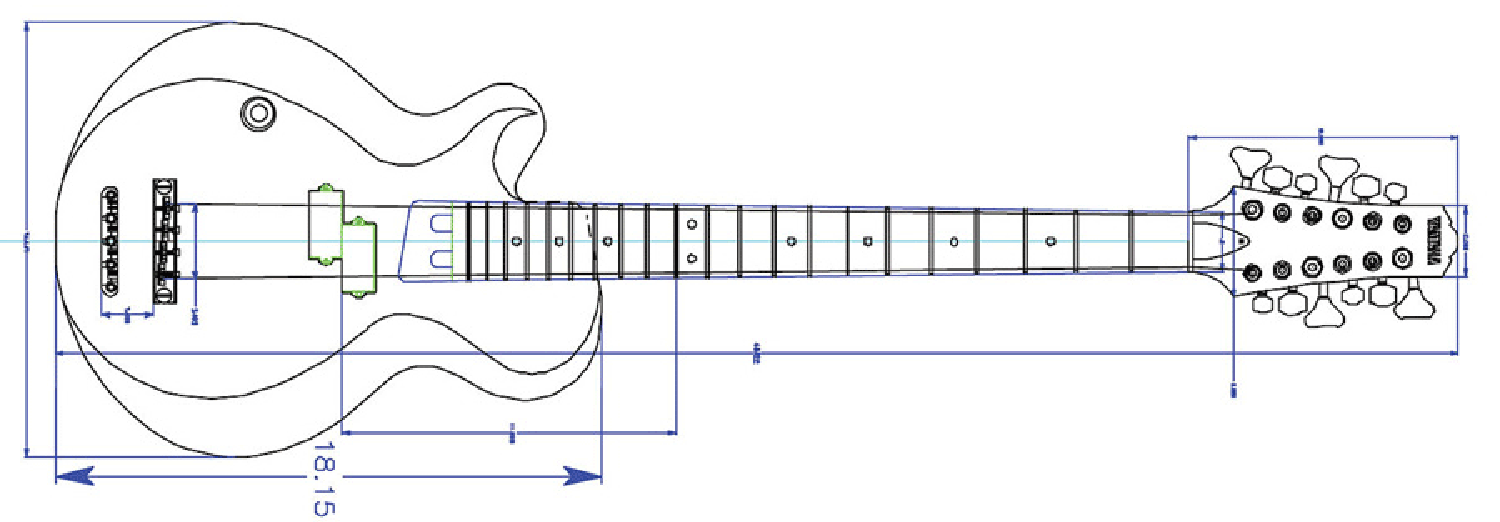12-String Bass Tailpieces
There are two primary types of 12-string bass tailpieces: 8-hole and 12-hole.
Hamer 8-hole tailpiece used on both 8-string and 12-string basses. It is designed so that the fundamental strings pass through the smaller hole, with the two octave strings utilizing the larger hole.
8-Hole Tailpieces
The 8-hole tailpiece was a standard feature of Hamer 12-string basses throughout the company’s existence, plus 8-hole tailpieces were also used on the Chandler Royale 12’s and a few other brands.
1987 Hamer B12S tailpiece with all holes being the same size.
Not all tailpieces used by Hamer are the same. Earlier basses have all the holes drilled to the same size, while later tailpieces have one hole larger than the other. The fundamental strings are strung through the smaller holes, with both octave strings sharing the larger hole. This works fine as long as the octave strings have the larger ball ends used for standard bass strings.
Chandler Royale 8-hole tailpiece.
Octave strings with the smaller guitar-size ball ends will slip through the holes since the ball ends are smaller than the holes. These strings can still be used as long as they are anchored somehow. Check here for ways to counter this problem.
12-Hole Tailpieces
Typical 12-hole tailpiece from a 12-string bass built in South Korea.
Waterstone 12-hole tailpiece.
Almost all 12-string basses made in Asia incorporate a 12-hole tailpiece. This type of tailpiece is made to be used specifically with the octave strings with the smaller guitar-sized ball ends. Not surprisingly, most 12-string bass string sets made in Asia have octave strings with these smaller ball ends.
USA-made string sets that have large ball ends on all strings will work fine with these tailpieces.
12-hole tailpiece used on a Hiroshi Kid’s 12-string bass.
Custom tailpieces
Emerald Guitars acoustic 12-string bass. The tailpiece is 5 layers of carbon fiber.
Doug Pinnick's custom Yamaha 12-string bass incorporates a custom-made tailpiece.
Whitehouse Guitars Sorta-Deluxe model with custom tailpiece.
8-hole tailpiece.
The back of the tailpiece.
Whitehouse Guitars Deluxe model with tailpiece mounted on the bottom of the body.
The tailpiece is aluminum and also serves as a ground.
The inside of the tailpiece cover.
8-hole tailpiece.
Matthias Haydn created a unique tailpiece with a separate post for each string for his custom 12-string bass..
potential Tailpiece Issues
A common criticism of the Hamer tailpiece is that it is positioned "backwards". By this the critics mean that the screws anchoring the tailpiece to the body should be underneath the ball ends rather than being underneath the strings on the side nearest the bridge. Hamer positioned their tailpieces this same way ever since building their first 8-string and 12-string basses.
A problem that has been reported with this style of tailpiece is that it may start to lift off the body due to the prolonged string tension.
An easy fix for a lifting tailpiece is to place a layer or two of tape underneath the tailpiece on the bridge side, then screw the tailpiece back down securely. This has the effect of flattening the body underneath the tailpiece that may have been compressed due to the string tension.
This custom aluminum tailpiece was made for James Hunting’s Hamer B12A 12-string bass by Alan Witherbey of Pasadena, California. It utilizes an inverted "T" shape with four screw holes on each side, which doubles the number of screws fastening the tailpiece to the body. James told us, "Whoever decided on the style of the tailpiece was not thinking design and durability at all. It belongs on a Fender Strat. I have amended their poor design." When changing strings James uses a discarded ‘E’ string to align the ball ends.
Tailpiece Maintenance
Be sure to regularly check the screws holding the tailpiece. The tailpiece anchors the entire stress of the accumulated string tension, which on a 12-string bass is considerable. Loose screws can rip out, damaging the finish in the process.
If the screws are becoming loose, larger screws may be necessary.
